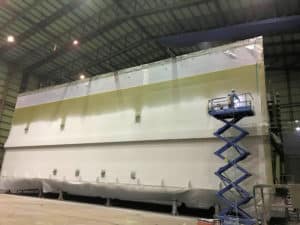PPG’s 30-year coatings protection for the world’s largest sea lock
In this article Arjan van Vliet, PPG KAM/Segment Sales Manager Infrastructure Europe, discusses the coating of the world’s largest sea lock.
The world’s largest sea lock, on the North Sea Canal near Ijmuiden, the Netherlands, as officially opened last year. The 500m long, 70m wide lock, which provides access to the port of Amsterdam, is also an important part of the primary flood defence of the Dutch coastline; it was built to a set of exacting standards, including a coatings system that will last for a minimum of 30 years.
The new lock replaces the smaller Noordersluis, which was nearing the end of its life after almost 100 years of service. The Dutch water authority, Rijkswaterstaat, awarded a contract for the new lock to the OpenIJ consortium for the design, construction, financing and maintenance of this new sea lock for 26 years. OpenIJ is a public-private consortium made up of BAM PPP PGGM (50%), and VolkerWessels and DIF (50%).
The decision was made to build a larger lock to account for the growing size of cruise and cargo ships and to ensure that the Port of Amsterdam can retain or even expand its market share. In addition to the passage of ships, the lock is used as a North-South road connection as well as a barrier that offers protection against the sea during storms, and that maintains the safety of millions of people in the Noord-Holland region.
There were also stringent requirements for the coatings system used on the lock gates and fenders. The sea lock is exposed to a range of destructive forces generated by fresh water and salt water: ships, tides, UV rays, sea mist, rain, condensation, and the continuous combined effects of oxygen and water. The coating system is required to provide effective and extended corrosion protection for over 30 years.
]
Initially, a fibre-reinforced polyester (FRP) product was stipulated in the contract coating specification. However, Rijkswaterstaat chose a more robust system that would provide the required 30-year protection span. That system consisted of PPG Sigmaprime 200 universal epoxy primer; PPG Sigmashield 880GF surface-tolerant, high-build glassflake epoxy and PPG Sigmadur 1800 high-solids polymeric urethane topcoat.
The epoxy system was chosen over the traditional FRP system based on our proven track record, combined with the ability to provide cross-border support. The system provides outstanding protection and is specifically designed for use in offshore splash zones and heavy-duty environments. The topcoat uses Versatic technology, which provides superior weathering resistance, enhanced gloss retention and superior chalking resistance compared to conventional polyurethane.
PPG’s global expertise was also valuable for this project to be executed smoothly. The PPG Netherlands team provided technical consultation to the project owner, while the PPG South Korea team was able to provide on-site field technical support during the fabrication phase in South Korea.
|
Project |
Ijmuiden Sea Lock |
|
Requirement |
30-year minimum corrosion protection against a range of destructive forces generated by fresh water and salt water: ships, tides, UV rays, sea mist, rain, condensation, and the combined effects of oxygen and water |
|
Coatings system |
Preservation system based on epoxy primer; high-build glassflake epoxy and high-solids polymeric urethane topcoat |
It is a great honour to be providing our coatings for such a major project for the Netherlands. The new sea lock is a hugely important piece of infrastructure that is vital not only for the country’s shipping industry, but also as a protection against the North Sea.

